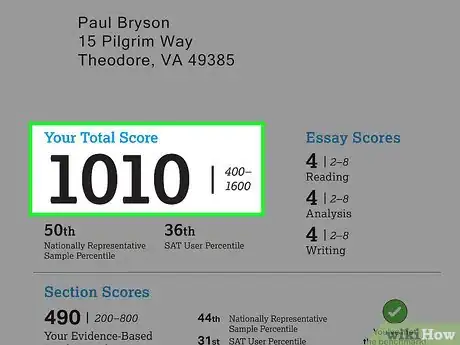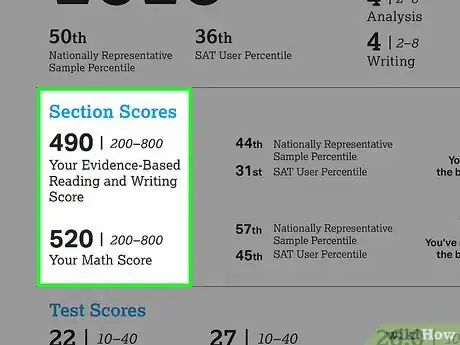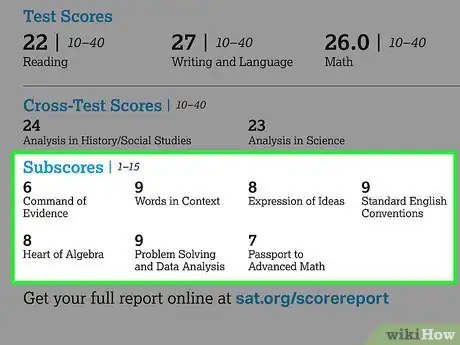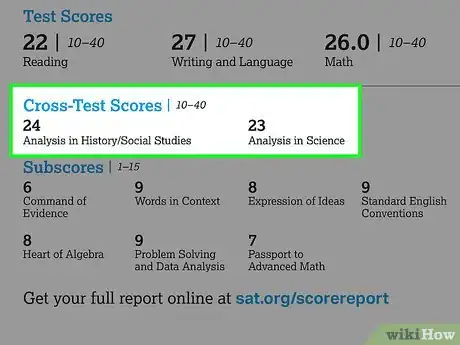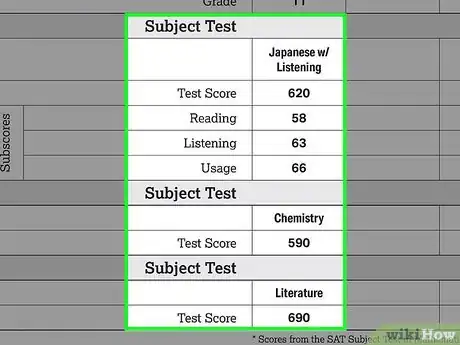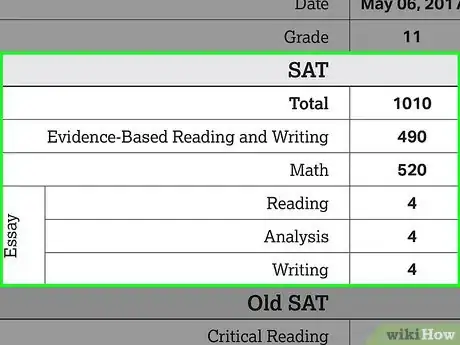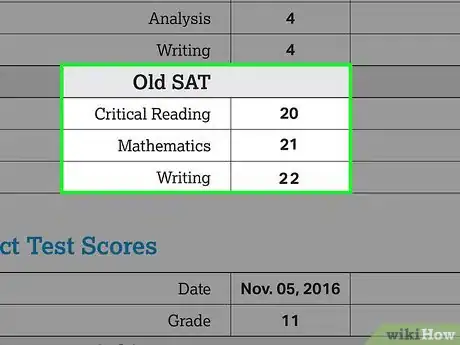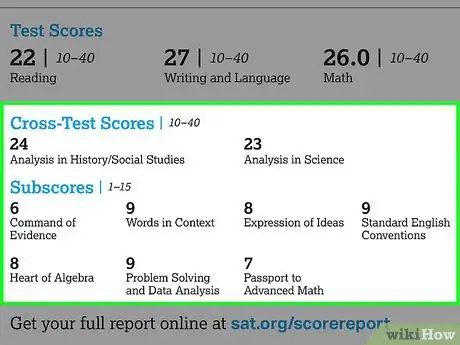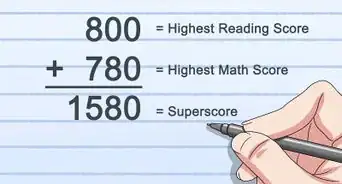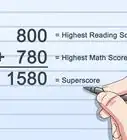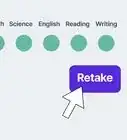This article was co-authored by Arash Fayz. Arash Fayz is the Co-Founder and Executive Director of LA Tutors 123, an academic consulting and private tutoring company based in Los Angeles, California. Arash has over 10 years of educational consulting experience, managing the tutoring of students of all ages, abilities, and backgrounds to score higher on standardized tests and gain admission to their target schools. He has a BA in Applied Mathematics and Computer Science from the University of California, Los Angeles.
This article has been viewed 13,654 times.
The latest version of the SAT goes back to the classic scoring system of two sections worth 200 to 800 points each, for a total score of between 400 and 1600. This version does away with the old required writing test and score system with an upper limit of 2400. On the other hand, score reports are now broken down into numerous types of scores, subscores, and percentiles. Weeding through those doesn't have to be difficult, as long as you know exactly what each score represents. Start by looking at your overall and section scores to get the big picture. Then, use the subscores to help you interpret the report and find your strengths as well as areas for improvement.
Steps
Finding Your Basic Scores
-
1Double-check your personal information. Find this at the top right of your score report. It will include your name, school, and other identifying data. Make sure that this information is correct. If it is not, contact the College Board to make sure that you did not receive the wrong scores.[1]
-
2Start with your total score, found on the left of your report. The total score, printed in large font, will be somewhere between 400 and 1600. That score shows the combined total of what you got on both the Evidence-Based Reading and Math sections of the SAT.[2]
- If you took a previous version of the SAT, it might have had a required essay that was also factored into your total score. This is no longer the case.
Advertisement -
3Find your section scores. Look directly below the total score, and you will see your section scores. There will be one for the Evidence-Based Reading section and another for the Math section. Each will be scored on a range of 200-800.[3]
Analyzing Score Details
-
1Look for the individual test scores. The SAT is actually made up of several different tests. Below the section scores on your score report, you will find scores for the different tests within the Evidence-Based Reading section: the Reading test and the Writing and Language test. These are scored on a scale of 10-40. You will also see a score for the math section scored on this same scale for comparison.[4]
- The individual test scores help you get a more specific idea of how you did on various parts of the SAT.
-
2Check your subscores for even more detail about your performance. At the bottom of page 1 of your score report, look for these subscores. They’ll be reported on a scale of 1-15. These scores report how well you did on questions that test various types of subject areas, tasks and concepts. These are:[5]
- Command of Evidence
- Words in Context
- Expression of Ideas
- Standard English Conventions
- Heart of Algebra
- Problem Solving and Data Analysis
- Passport to Advanced Math
-
3Locate your cross test scores. Check the lower half of the first page of your score report, where you will see scores for areas called “Analysis in History” and “Analysis in Science.” Both of these are scored on a scale of 10-40. While the SAT does not test subject knowledge of History or Science, these scores show how you did on questions from across the test that examine skills that are relevant to these subjects.[6]
- These scores can give you a sense of how well you might do, potentially, in college courses in History, Science, or related subjects.
Reviewing Optional Test and Repeat Test Scores
-
1Find your subject test scores. If you took one of the SAT subject tests in an area such as a foreign language or chemistry, you’ll find these on the second page of your score report. Like the main sections, they’ll be scored on a range of 200-800 each.[7]
-
2Check your essay writing score, if you took that test. The writing test is no longer a required section of the SAT. If you registered to take the optional writing test, you will find your score on the first page of your score report, to the right of the total score. The essay writing test is scored on a scale of 2-8.[8]
-
3Review your old scores, if applicable. If you have taken the SAT previously, your report will include your old scores as well as your new ones. Look on page 2 of your score report for a breakdown of previous scores, listed in columns next to your latest ones.[9]
Interpreting Your Scores
-
1Review your percentiles. You will find 2 types of percentiles on your score report. The “Nationally Representative Sample Percentile” compares your scores to a statistical sample of 11th and 12th graders. The “SAT User Percentile” compares your scores to typical SAT takers.[10]
- You score report will list percentiles for your total scores and section scores.
- For example, if you scored in the 75th percentile for your total score, this means that your score was better than 75 percent of other test takers’.
-
2Check your benchmark indicators. Look to the right of your section scores. You will see color-coded symbols that indicate whether or not you met a certain benchmark determined by the College Board. A green check mark means you met the benchmark for a section’s subject (reading or math), while a yellow exclamation point means you did not.[11]
- The benchmarks are way of indicating whether or not you have a 75 percent or higher chance of earning a “C” or higher in a first-year college course that would use these subject area skills, according to the College Board’s standards.
-
3Use cross test scores and subscores to identify areas for improvement. Look realistically at these portions of your score report. If you scored relatively low in a particular area, such as “Heart of Algebra” or “Words in Context,” you can take a related course or do extra study in this area. That way, you can build your skills in the area, and potentially score higher on the SAT if you take it again.[12]
- Talk to your school’s guidance or college counselor if you want some advice on improving your academic skills and/or test scores based on the cross test scores.
-
4Look for your score range information. Go to http://sat.org/scorereport for an even more in-depth report. Your online report has something called the Skills Insight tool to help you figure out areas that need improvement. Online, you can also find your score variations, which tells you how much your score is likely to rise or fall if you take it again, based on your test performance.
Expert Q&A
-
QuestionWhat is the most important section on the SAT?
 Arash FayzArash Fayz is the Co-Founder and Executive Director of LA Tutors 123, an academic consulting and private tutoring company based in Los Angeles, California. Arash has over 10 years of educational consulting experience, managing the tutoring of students of all ages, abilities, and backgrounds to score higher on standardized tests and gain admission to their target schools. He has a BA in Applied Mathematics and Computer Science from the University of California, Los Angeles.
Arash FayzArash Fayz is the Co-Founder and Executive Director of LA Tutors 123, an academic consulting and private tutoring company based in Los Angeles, California. Arash has over 10 years of educational consulting experience, managing the tutoring of students of all ages, abilities, and backgrounds to score higher on standardized tests and gain admission to their target schools. He has a BA in Applied Mathematics and Computer Science from the University of California, Los Angeles.
Test Prep Tutor The most important parts of the score report are the scores for the evidence-based reading and writing and math sections. Those scores will be out of 800, then your total score is out of 1600.
The most important parts of the score report are the scores for the evidence-based reading and writing and math sections. Those scores will be out of 800, then your total score is out of 1600.
References
- ↑ https://collegereadiness.collegeboard.org/pdf/understanding-sat-scores.pdf
- ↑ https://collegereadiness.collegeboard.org/pdf/understanding-sat-scores.pdf
- ↑ https://collegereadiness.collegeboard.org/pdf/understanding-sat-scores.pdf
- ↑ https://collegereadiness.collegeboard.org/pdf/understanding-sat-scores.pdf
- ↑ https://collegereadiness.collegeboard.org/pdf/understanding-sat-scores.pdf
- ↑ https://collegereadiness.collegeboard.org/pdf/understanding-sat-scores.pdf
- ↑ https://collegereadiness.collegeboard.org/pdf/understanding-sat-scores.pdf
- ↑ https://collegereadiness.collegeboard.org/pdf/understanding-sat-scores.pdf
- ↑ https://collegereadiness.collegeboard.org/pdf/understanding-sat-scores.pdf

